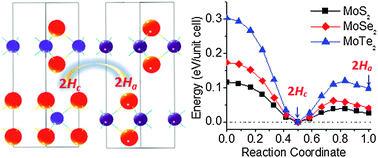Pressure evolution of the potential barriers of phase transition of MoS2, MoSe2 and MoTe2
Abstract
Two-dimensional crystals with weak layer interactions, such as twisted graphene, have been a focus of research recently. As a representative example, transitional metal dichalcogenides show a lot of fascinating properties due to stacking orders and spin–orbit coupling. We analyzed the dynamic energy barrier of possible phase transitions in MoX2 (X = S, Se and Te) with first-principles methods. In the structural transition from 2Hc to 2Ha, the energy barrier is found to be increased following an increase of pressure which is different from the phase transition in usual semiconductors. Among MoS2, MoSe2 and MoTe2, the energy barrier of MoS2 is the lowest and the stability of both 2Hc and 2Ha is reversed under pressure for MoS2. It is found that the absence of a phase transition in MoSe2 and MoTe2 is due to the competition between van der Waals interaction of layers and the coulomb interaction of Mo and X in nearest-neighbor layer of Mo in both phases.


 Please wait while we load your content...
Please wait while we load your content...